Quickest way to lower your Testosterone (Patreon)
Downloads
Content
Over the past two decades, American men’s testosterone has rapidly declined.
Thomas Travison, PhD, author of the paper A Population-Level Decline in Serum Testosterone Levels in American Men says they observed an overall decrease in testosterone in men over the years across a wide range of ages.
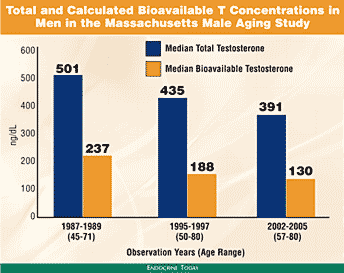 </figure>
</figure>Worse, sperm concentrations have cut in half since 1973.
<figure>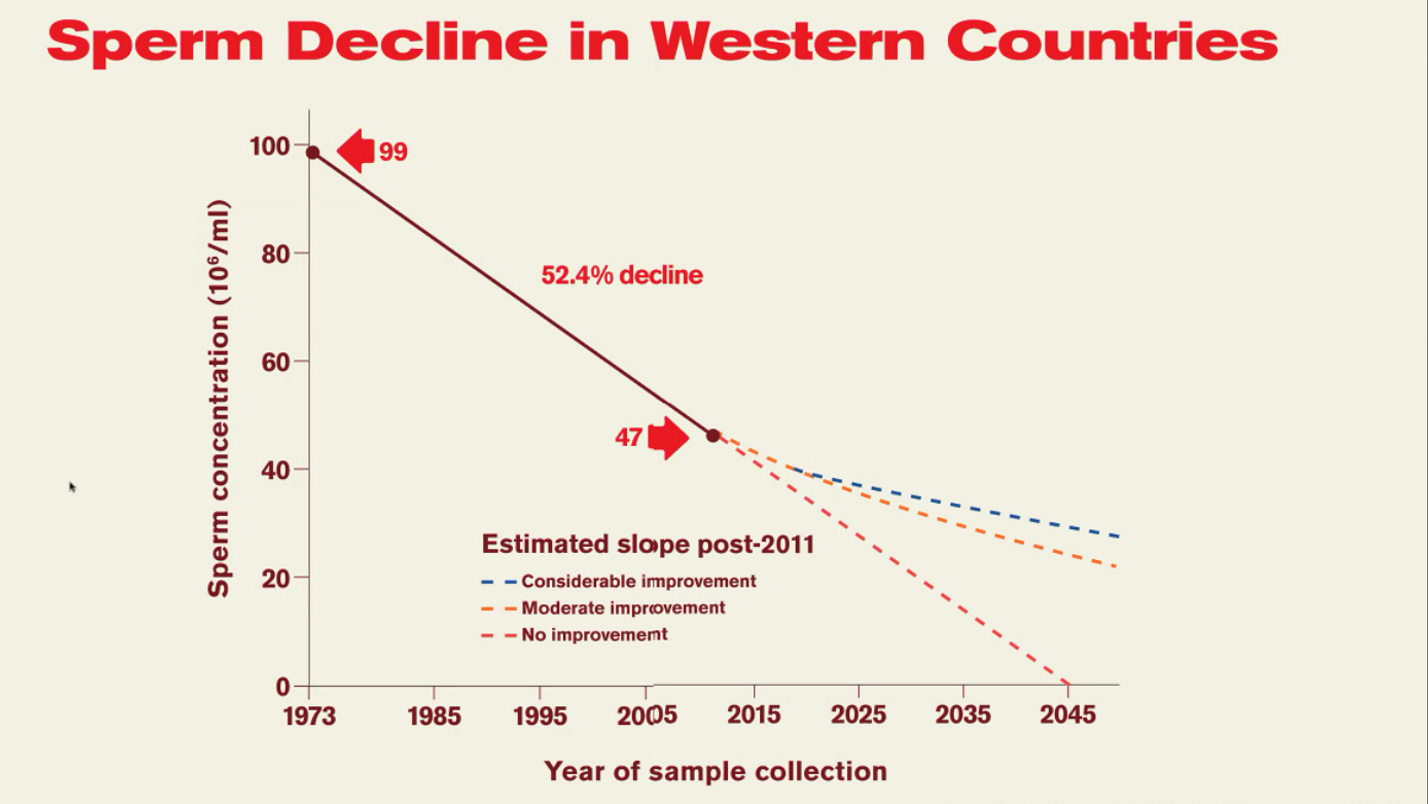 </figure>
</figure>As you’d expect, fertility rates decline as testosterone does.
<figure>Why are men's testosterone levels decreasing? - Parla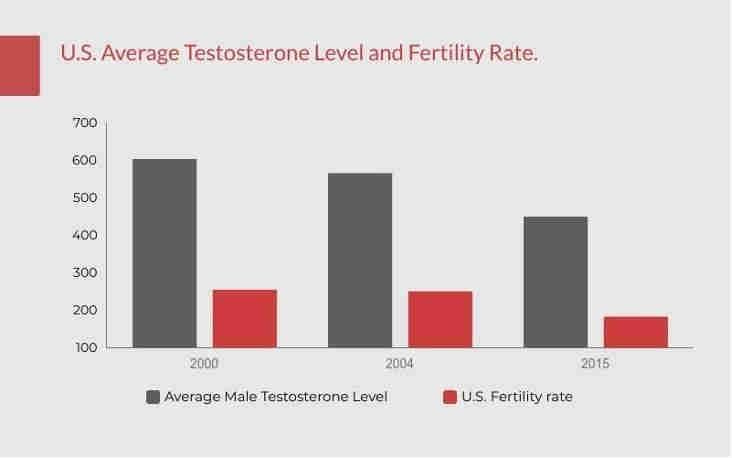 </figure>
</figure>There are many factors to this decline in testosterone, sperm quality and fertility. One suspect is our more sedentary lifestyles. We’ve all heard about how bad a sedentary lifestyle and sitting for hours on end is awful for our health. Pretty straightforward: move less, get fat.
<figure>https://doi.org/10.1016/j.jshs.2022.10.001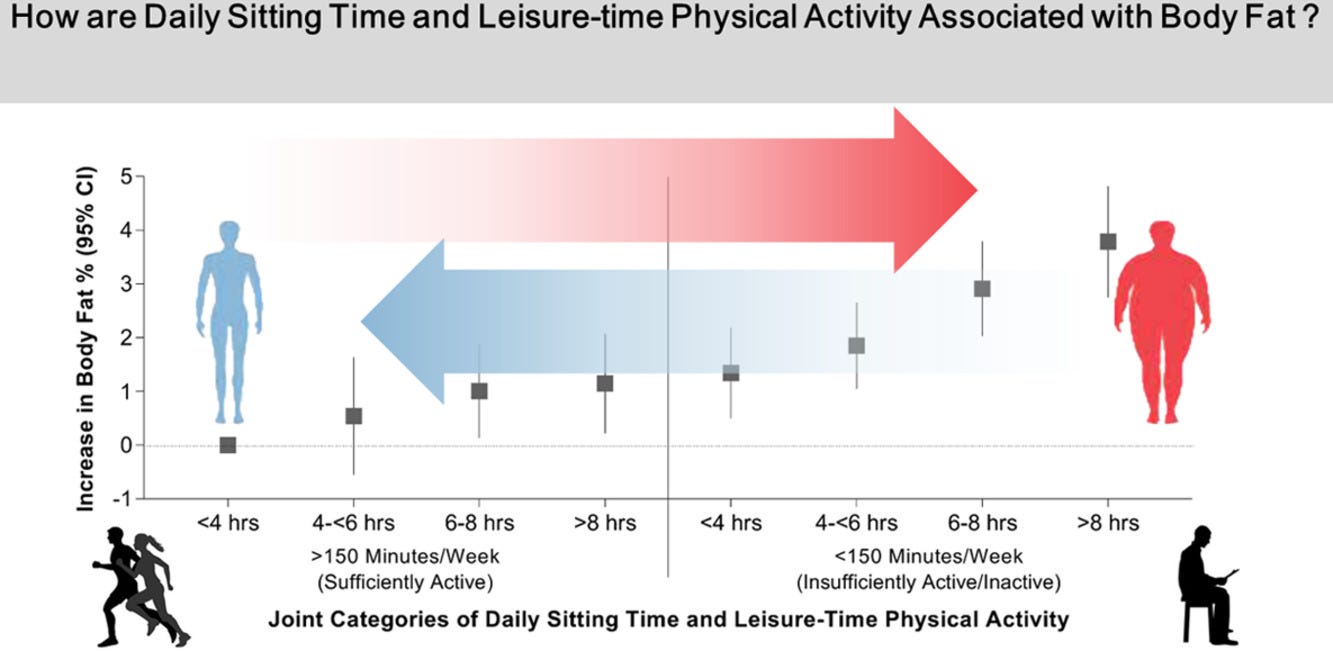 </figure>
</figure>But what if sitting itself had a direct effect on men’s testicles, testosterone levels and sperm production? Imagine that while you sat down, you had a tiny mouse wedged between your thighs and the chair cushion. That mouse would probably be pretty damn hot. Well, this is basically what’s happening to your testicles when you sit down: they’re heating up. Men may be told ‘come on, your balls aren’t that big,’ or criticized for assuming such a childish ‘dominance’ posture when they spread their legs wide when sitting - what some people call ‘manspreading.’ However, it may just be an instinctual urge to keep the testicles cooler.
<figure> </figure><figure>
</figure><figure> </figure>
</figure>The scrotum has a natural cooling mechanism that works by increasing the exposed surface area. This is why your testicles hang lower when it’s hot outside. Your testicles simply don’t work as well when they overheat.
POLL
Are you confident your balls are at the right temperature?
Yes.
9%
No.
39%
I think not optimal, not terrible.
46%
I don't have balls.
7%
319 VOTES · · SHOW OPTIONS
<figure> </figure>
</figure>Several studies have found that even a small increase in ball temperature leads to dramatic degradation of sperm quality. High temperatures affecting sperm quality has been known since the 1920’s. A 1967 paper looking at the effect of a mere 0.8° C increase in ball temperature starts by saying:
In both beast and man, testes exposed to temperatures that exceed physiologic limits suffer suppression of spermatogenesis. …it has been clearly shown that the deliberate application of heat to the scrotum brings about a reduction in the sperm counts of normal, euspermic subjects.
In the study, they maintained a group of 10 healthy men’s balls at +0.8° C for 15 hours per day. They observed an 80% reduction in sperm count over the 2-3 month period of the study.
Another 1985 study tried +2° C on the balls for 15 hours a day, this led to a 90% reduction in sperm count. Luckily the effect was reversed after 3-4 months of giving the balls a break from the heat. By the way this study was suspecting scrotal heating could be a form of contraceptive.
You can find plenty more studies like this that show that the balls do not like heat.
<figure>underdogfertility.com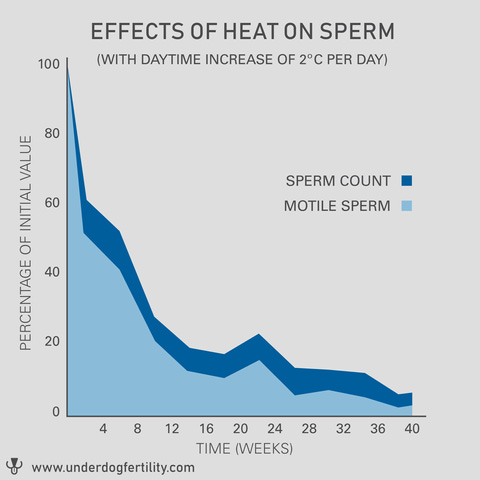 </figure>
</figure>What else might increase your ball temperature? Tight underwear. This below graph is from a study titled Mild induced testicular and epididymal hyperthermia alters sperm chromatin integrity in men and shows that sperm count declines when men wear tight underwear. This is thought to be the result of not allowing the testicles to freely hang and maintain distance from the body. Being pressed up against the body heats up the testicles. Sperm count increased when the subjects stopped wearing the tight underwear.
<figure>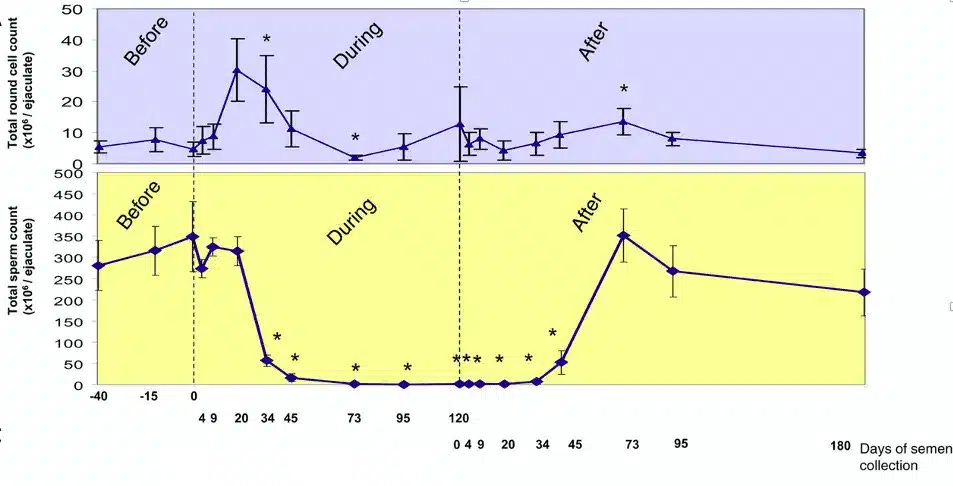 </figure>
</figure>This study notes that if you want to preserve the integrity of a semen sample itself, it needs to be kept at a very cool 20 degrees celsius. In another study, it was found that the hotter the testicles in infertile men, the more messed up their sperm was:
In the infertile men, it was found that the higher the scrotal temperature, the more alterated the sperm characteristics.<figure>
 </figure>
</figure>What about testosterone?
Having top-notch sperm is cool and all, but for us guys not trying to have a baby, we’re more concerned with testosterone. Does heating really mean bad ball function overall or it simply that sperm itself doesn’t handle heat well, so testosterone isn’t affected?
The host of the youtube channel Ergogenic Health claims that icing the balls was a key component of a testosterone boosting protocol that got his testosterone to about 990 ng/dL.
Well, testosterone is in fact important for proper production and function of the sperm. Per a paper titled Non-classical actions of testosterone and spermatogenesis:
”Testosterone is essential to maintain spermatogenesis and male fertility. In the absence of testosterone stimulation, spermatogenesis does not proceed beyond the meiosis stage. After withdrawal of testosterone, germ cells that have progressed beyond meiosis detach from supporting Sertoli cells and die, whereas mature sperm cannot be released from Sertoli cells resulting in infertility.” (S)
Testosterone is necessary for the sperm to develop into the proper, functional shape(S):
“Testosterone is important for the conversion of step 7 round spermatids into step 8 spermatids by regulating the adhesion between Sertoli cells and round/elongating/ elongated spermatids at the apical ectoplasmic specialization adherent junctions.[44-47]”<figure>
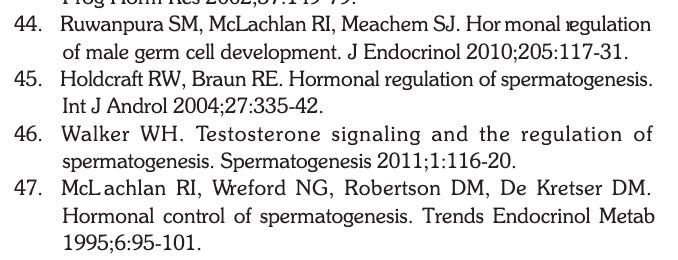 </figure>
</figure>In this study where they were corrected an iron deficiency in anemic males, they found a clear correlation between increases in testosterone and increase in total sperm count in response to iron replacement therapy.
<figure>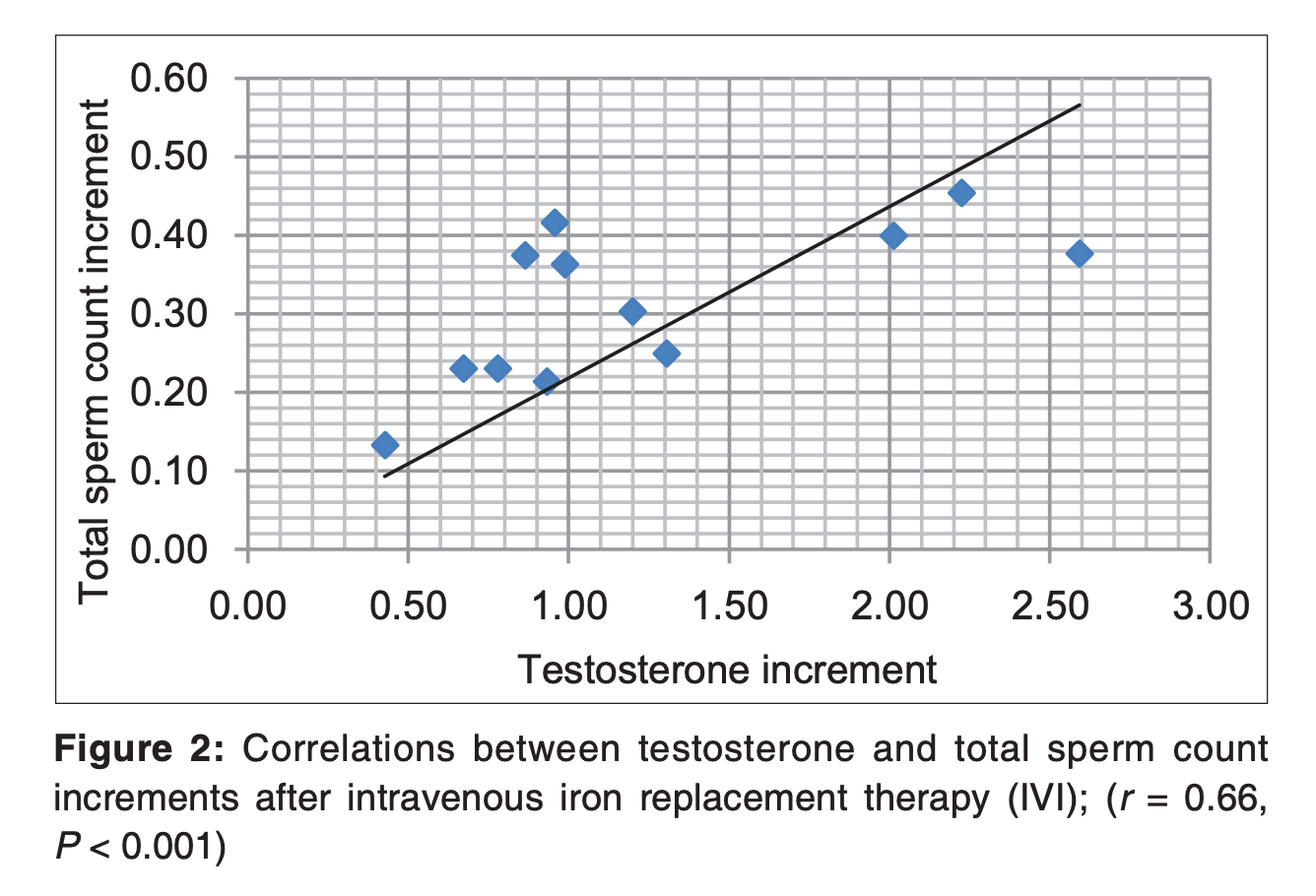 </figure><figure>
</figure><figure> </figure>
</figure>It’s well known that hot bulls are less fertile, presumably because their balls overheat. As we’d expect, a 2020 study found that increased testicle temperature reduced testosterone concentrations in the bull’s testicles. The temperature increase from just insulating the bulls’ testicles “induced a profound (10-fold) reduction in testicular testosterone concentrations after 48 h.”
As we would expect, the Cleveland Clinic confirms that “In men and [men], decreased fertility is commonly associated with low testosterone levels.”
Can’t get pregnant? Ice the balls.
<figure>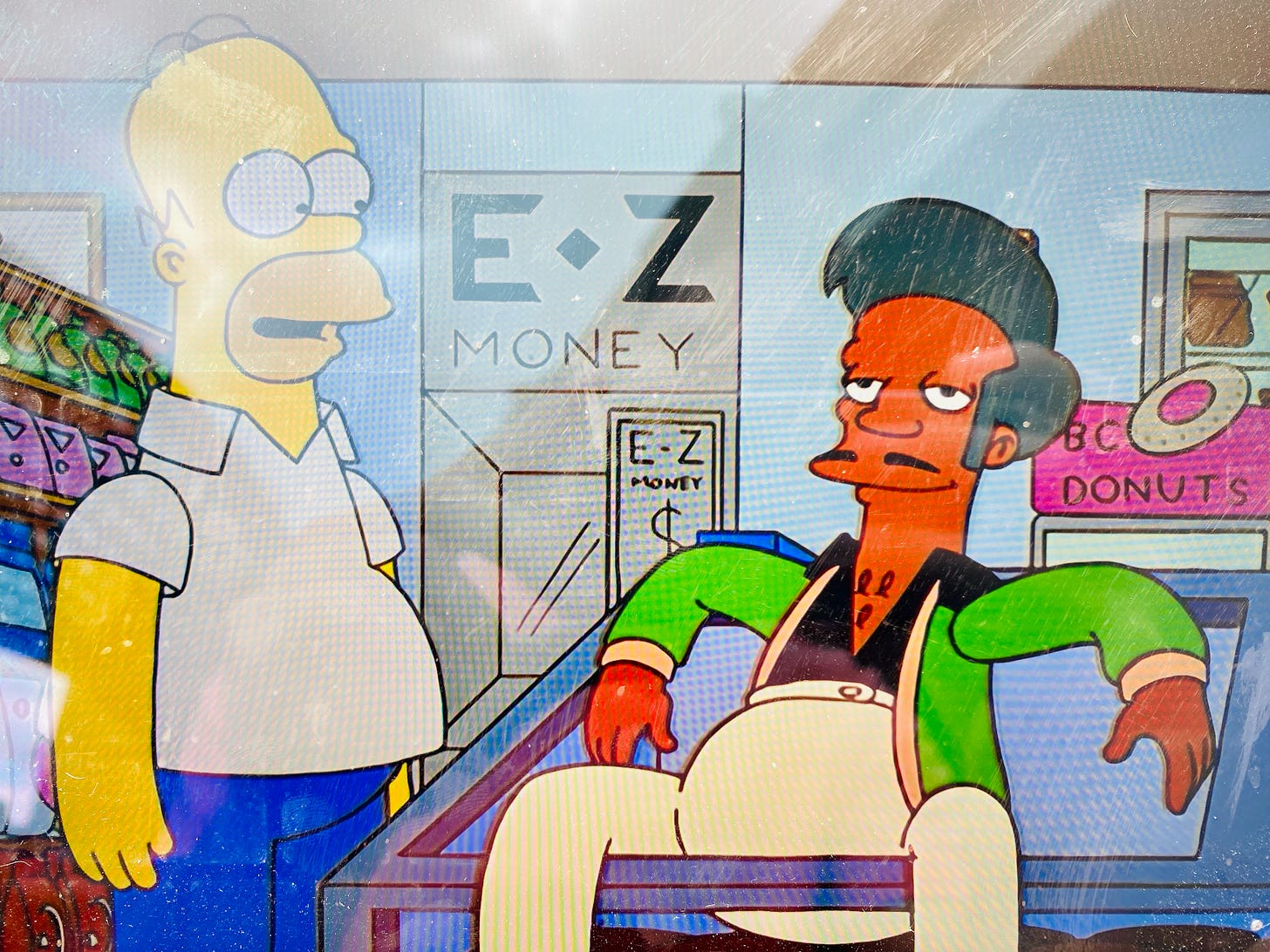 </figure>
</figure>“Hey Apu, sittin’ in the ice cream cooler, ey?”
“By chilling my loins, I increase the chances of impregnating my wife.”
<figure> </figure>
</figure>"Mr. Hill, research shows that heat lowers fertility. One way to increase the number of healthy sperm is to lower the temperature."
“In the house?”
“In your pants.”
Hank and Peggy Hill were having trouble conceiving, so they decided to go to a fertility doctor. Hank was feeling pretty confident when he learned that his sperm count was a whopping 8 million. When he learned that that was actually about only 10% of the average man’s sperm count, Hank Hill decided to embark on a ball-cooling journey.
<figure> </figure><figure>
</figure><figure> </figure><figure>
</figure><figure>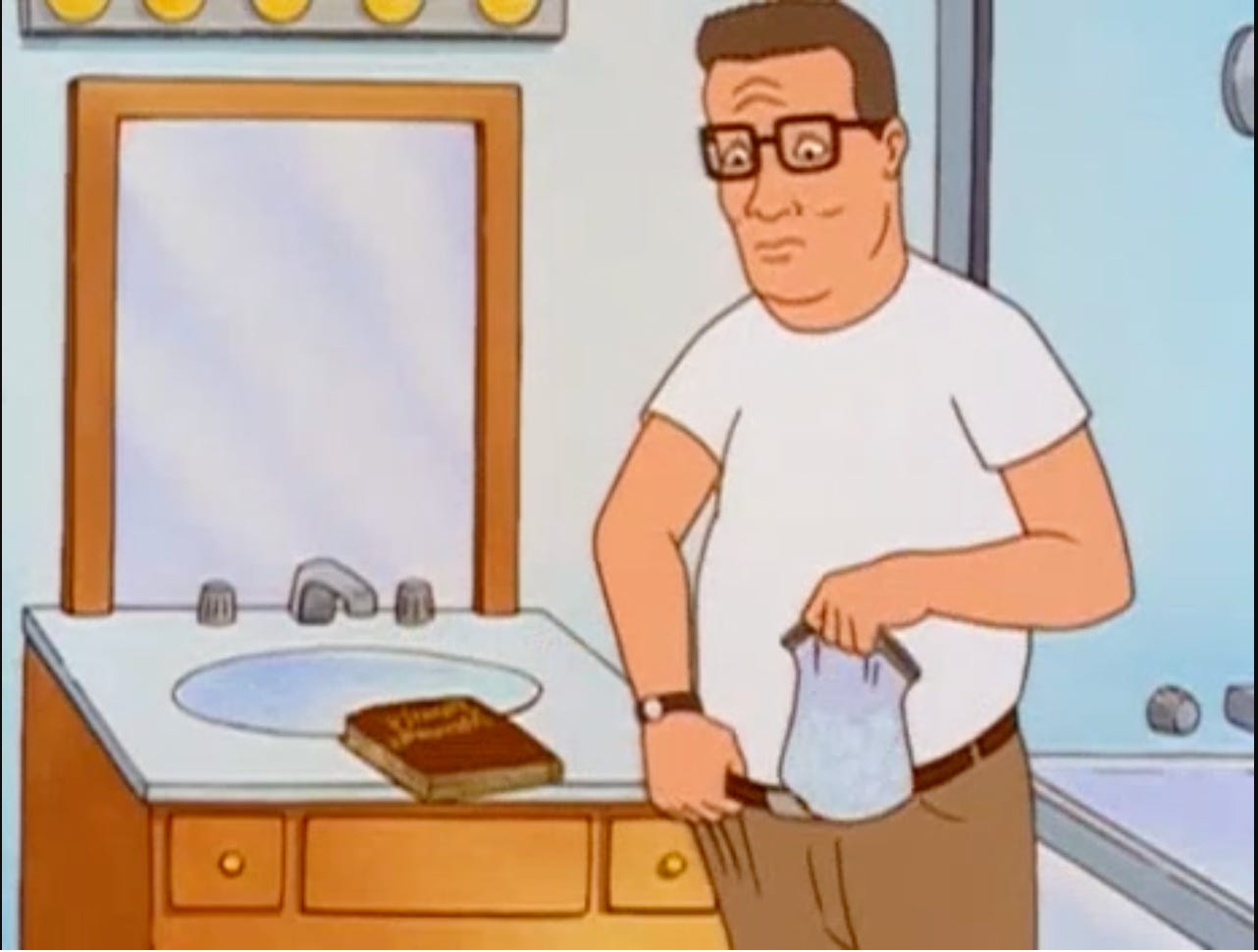 </figure>
</figure>Even though the writers for The Simpsons and King of the Hill have not indicated so, I’m going to assume these scenes were based on a 1984 study on infertile couples published in The Journal of Urology. (Despite the fact that high temperatures affecting sperm quality has been known since the 1920’s.) The study was looking at 64 infertile men who had “subfertile” semen. The men wore a testicular hypothermia device (ball chiller) daily for at least 16 weeks.
“Of 64 men who wore the testicular hypothermia device for more than 16 weeks, 42 (65.6%) had improvement in semen, and pregnancy occurred in 17 (26.6%).”“…the testicular hypothermia device provides a noninvasive method for the treatment of poor semen associated with elevated testicular temperature. United States Food and Drug Administration approval was granted in December 1984”
Another study titled Chronic scrotal hypothermia as a treatment for poor semen quality reported successful pregnancies after chilling the balls:
“Six men with infertile marriages associated with poor semen and raised testicular temperature were treated by an experimental appliance... This was worn with little discomfort for as long as 24 h a day and for periods as long as 20 weeks. Three wives became pregnant while their husbands were on treatment. Semen analysis at the time of the missed menses showed improvements in all three men. In two patients who did not achieve a pregnancy, semen improvements were also seen after 12 weeks. The improvements in semen quality cannot be attributed to any agency other than the hypothermia.”
Yet another study had found ball-chilling to help sub-fertile men successfully impregnate their wives. Six couples were finally able to conceive after 6 straight years of infertility:
“Chronic scrotal hypothermia to 25 patients with infertility and elevated testis temperature resulted in varying degrees of improvement over their pretreatment poor semen in 16/25. Pregnancy occurred in 6/25 "hard core" infertile couples (mean period of infertility 6.0 years) after wearing an evaporative scrotal cooling device for sixteen hours daily for a mean of 14.5 weeks. … Discontinuance of hypothermia resulted in a return to pretreatment poor semen. Elevated temperature plays a role in poor semen” (S).<figure>
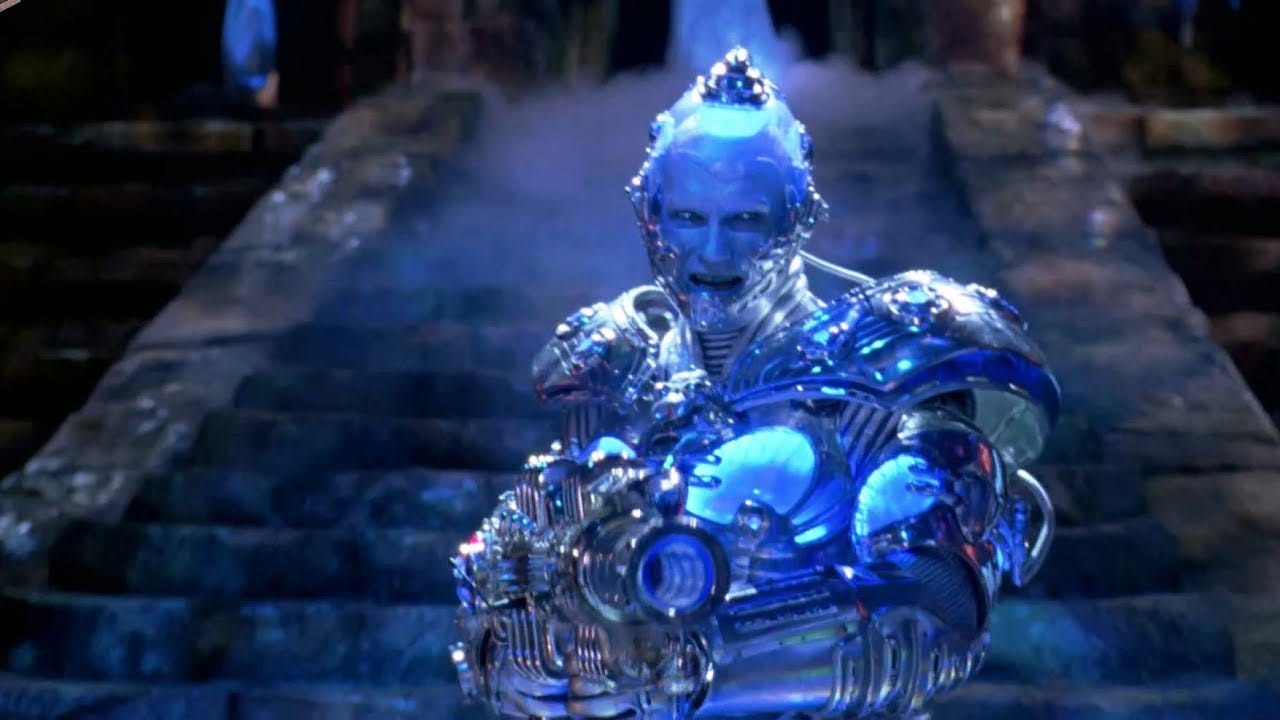 </figure>
</figure>They also remarked that “the offspring of such hypothermia-treated fathers appear to be normal.” Maybe the researchers expected the kids to be like Mr. Freeze from 1997’s Batman & Robin.
The interesting link between defective balls, temperature and testosterone.
<figure>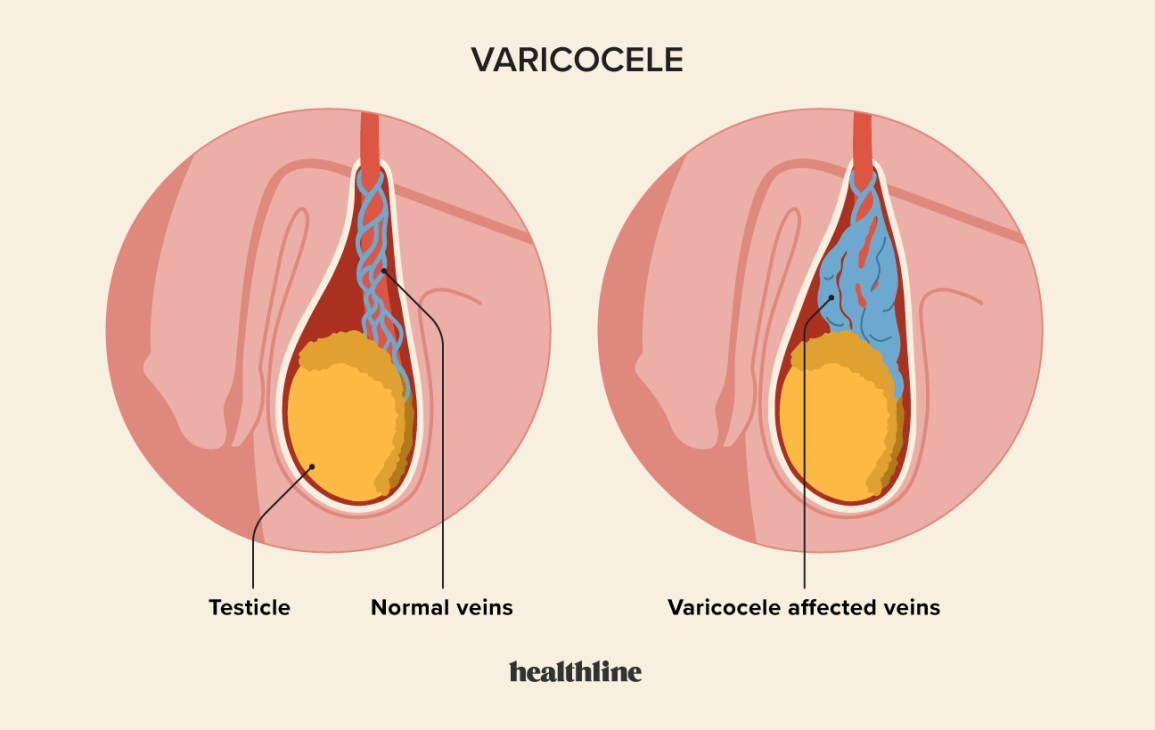 </figure>
</figure>Varicoceles are an abnormality in the “spermatic cord” (basically swollen veins in the scrotum) which can impair sperm as well as testosterone production. 15% of men suffer from this condition, though many of them are asymptomatic. However, among infertile men, the incidence of varicocele has been observed to be as high as 35–40%.(S) The 1984 paper Scrotal hypothermia: new therapy for poor semen suggests that some men’s poor semen quality may be the fault of an innate inability for their testes to properly regulate their temperature. They tested a ball-cooling device on men who had some form of varicocele. Semen quality in many of the men improved and pregnancies resulted. The implication is that perhaps one effect of these varicoceles is that they prevent the testicles from regulating their temperature properly.
The reason this is interesting is that this suggests:
・Varicocele → Hotter Testicles → Lower Testosterone
・Removing Varicocele → Cooler Testicles → Higher Testosterone
 </figure>
</figure>“Patients with varicoceles may thus present simultaneously or independently with symptoms of testosterone deficiency, including decreased libido, erectile dysfunction, fatigue, depressed or changes in mood, decreased bone mineral density, weight fluctuations, and insulin resistance.”
There is evidence that links varicoceles to lower testosterone. A paper titled Varicocele Treatment and Serum Testosterone says that:
・Patients with varicocele on average have lower testosterone.
・Data shows that surgery removing the varicocele increases serum testosterone levels.
This paper titled: Effect of Varicocele and Its Treatment on Testosterone in Hypogonadal Men with Varicocele: Review of the Literature
Experience from large clinical studies in the literature suggests that varicocele repair may increase serum testosterone level in men with varicoceles and testosterone deficiency. Approximately 60%-80% of men with low serum testosterone will exhibit normalization of testosterone level after varicocele repair.
60-80% seems pretty huge to me.
The paper reduction in testicular temperature after varicocelectomy in infertile men is a solid piece of evidence linking dysfunctional temperature regulation in the balls and low testosterone:
“Testicular temperatures were elevated bilaterally in men with both unilateral and bilateral varicoceles. Both unilateral and bilateral microsurgical varicocelectomy results in a bilateral decrease in testicular temperature. These results support the hypothesis that a defect in testicular thermoregulation contributes to the pathophysiology of varicocele and demonstrate, for the first time in humans, the efficacy of varicocelectomy in restoring normal testicular temperatures.”
Takeaway
At the end of the day, there’s a reason why your testicles are situated outside of your body.(S) “In men and in most mammalian species, normal physiological spermatogenesis requires a testicular temperature that is 2–6 °C below the core body temperature” (S)
Keep your Balls from overheating at all costs
There’s no shortage of studies finding that cooling the scrotum had a positive impact on semen parameters. (1, 2, 3, 4, 5, 6, 7, 8). This is huge for couples considering that “in about 50% of cases, couple infertility is attributable to the male partner, mainly due to a failure in spermatogenesis.” (S)
Further, while most of the evidence is focused on the sperm improvements from ball-cooling, there are some lines of evidence suggesting that cooling down hot balls can have great benefit for testosterone levels.
Avoid Tight Underwear, Sitting & Driving too much
<figure>Mean right scrotal temperature in nine men while walking outside and driving a car.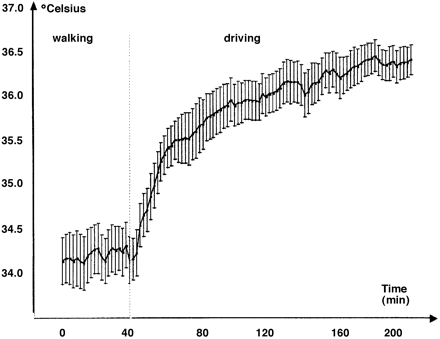 </figure>
</figure>・A study titled Increase in scrotal temperature in car drivers found, as you can see in the figure above, a significant increase in scrotal temperature in car drivers.
・As discussed earlier, sperm count declines when men wear tight underwear, presumably because the testicles are heated from being pressed against the body.
・It’s already accepted that it’s best to have the bedroom cool for better quality sleep, but it’s also a good idea to make sure your crotch isn’t getting too hot overnight.
 </figure>
</figure>The ball icing protocol I follow:
・2-3 times a day.
・8-12 minutes each session.
・Place an ice pack on the scrotum over your underwear.
・Don’t apply directly to the skin.
・If your underwear is too thin, the ice pack may become uncomfortable.
・You may need to adjust the position of the ice back if it’s uncomfortably cold.
・If you’re starting to feel a slight dull pain/numbness, that’s likely the sign that your icing session is up.
*Others have said it’s best to do right before bed. Personally I have found it hard to sleep due to a substantial increase in libido 20-30 minutes after the icing session. Could be a placebo issue.
There’s this rumor that Chinese powerlifters iced their balls right before attempting to hit a PR. The best I could find was this reddit thread from 9 years ago that links to a blog that no longer exists. However thanks to user “nothanksjoff,” we know the gist of the article:
<figure> </figure>
</figure>